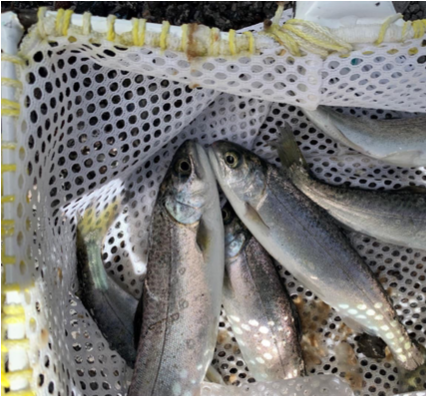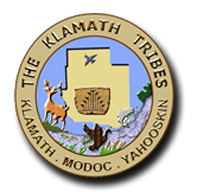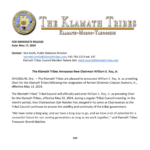FOR IMMEDIATE RELEASE Date: May 12, 2023
Contacts:
Clay Dumont, Chairman Klamath Tribes
cdumont.council@klamathtribes.com
Ken Smith, Public Relations Director kenneth.smith@klamathtribes.com; 541-783-2219 ext. 147
Mark Buettner, Ambodat Environmental Scientist mark.buettner@klamathtribes.com
Klamath Tribes Collaborates with Other Agencies to Return Chinook Salmon to Upper Klamath Basin
CHILOQUIN, Ore. — There is a stir of excitement at the Klamath Tribes Ambodat Department with the first steps being taken to bring Chinook salmon back to their Klamath homeland. Recently, Shahnie Rich and Lottie Riddle, Klamath Tribal members and employees at Ambodat, joined a team of biologists and partners in tagging juvenile Chinook in order to study their downstream movement through the Upper Klamath Basin.
Rich was one of several fish surgeons that implanted acoustic tags in the juvenile salmon to track their movements from their release sites on the Wood and Williamson Rivers, through Upper Klamath Lake and downstream in the Klamath River. This was a collaborative effort involving the Klamath Tribes, Trout Unlimited, Bureau of Reclamation, Bureau of Land Management, California Department of Fish and Wildlife, Cal Poly Humboldt, Oregon State University, U.S. Geological Survey, National Marine Fisheries Service, and U.C. Davis.
The c’iyaal’s (salmon) along with c’waam (Lost River sucker), koptu (Shortnose sucker), and meYas (trout) were important food resources for the Klamath Tribes for thousands of years. Tribal peoples lived in harmony with
the land and its natural resources. They were caretakers of the land, water and natural resources through traditional ecological knowledge.
However, with settlement, there were major changes to the Klamath Basin associated with irrigated agriculture, logging, livestock grazing, flood control, road construction, power generation and other developments. Chinook salmon, which spend several years in the ocean before migrating to rivers over 275 miles up the Klamath River to spawn, have been blocked since 1912 when the first dams were installed. Fortunately, the four major Klamath River dams are scheduled to be removed by 2024, allowing the salmon free passage back to the Upper Klamath Basin.
“After the Klamath River dams are removed next year, the spring-run of Chinook are not expected to re-populate in tributaries above Upper Klamath Lake on their own,” said Mark Buettner, Ambodat Environmental Scientist. “Studies like this one are being done to determine how they navigate streams and rivers.”
The fish originated from the Trinity River Hatchery as eggs, which were transported to the Klamath Hatchery for rearing to the optimal size. On April 12, in the Williamson River, 350 salmon were released, and in the Wood River, 352.
Rich, the Restoration Project Manager for Ambodat, stated that through this release of salmon, they can gain understanding of how the fish use the Upper Klamath Basin system and the barriers they face. “I think the information from this study can really help us narrow down the areas that are already working well for anadromous fishes,” she said, “but also point out areas that are in need of restoration, and help provide us a more focused approach to restoring the Upper Klamath Basin.”
Riddle, a Hydrologic Technician for Ambodat, said she is eager to see what the data from the study reveals about how the salmon navigate the waterways. “I am hoping it will help to identify areas that will be challenging for them to find passage so those areas can be improved and restored,” she said. “As a Klamath Tribal member, I’m grateful to have been able to help with this project, and proud to have a small role in the initial steps to bring our c’iyaal’s back home.”

Chinook salmon smolt at the Klamath Hatchery.
(Photo credit: Ken Smith/Klamath Tribes. Image is available for media use.)





